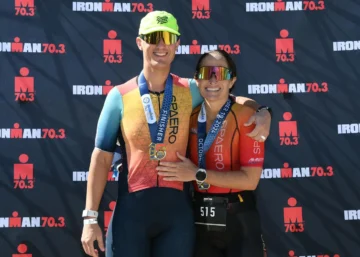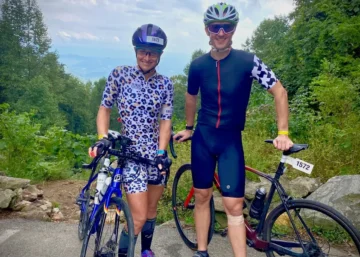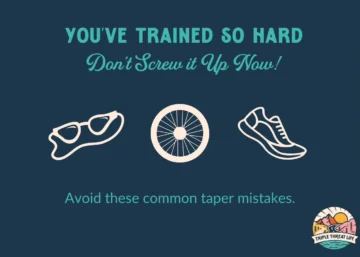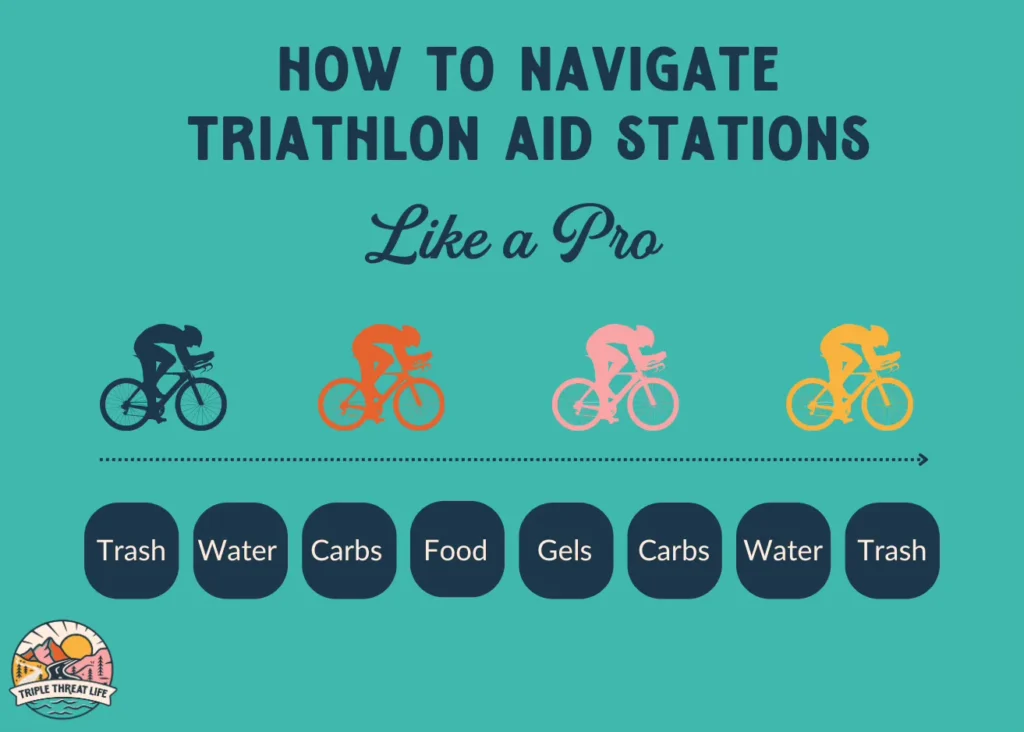
When I was getting ready to do my first 70.3 triathlon, I reached out to some of my friends, who were more seasoned triathletes, to get their best pieces of advice.
I’ll never forget what one of them said.
“Be careful going through aid stations. They’re one of the most dangerous parts of a triathlon.”
Now that I’ve done seven 70.3 triathlons, and one Ironman, I can confirm that he was correct. (Of course, we could also add the swim start and the bike mount line to that list, but those are topics for another time.)
Navigating an aid station in a triathlon with thousands of athletes, like a 70.3 or Ironman, can be tricky, not to mention dangerous.
If you’ve never done a big race with aid stations before, imagine a pack of carb-deprived squirrels, hyped up on adrenaline, descending on a pile of nuts. That gives you a pretty good picture of what an aid station feels like.
Every squirrel for himself!!!
All joking aside, I’ve seen races end for many athletes at aid stations because they hit a dropped bottle or ran into another athlete on the bike.
This isn’t to scare you. It’s to make sure you’re prepared. “By failing to prepare, you’re preparing to fail.”- Benjamin Franklin
So, we’re going to run through everything you need to know to navigate triathlon aid stations like a pro.
But first, join me in sending prayers and best wishes to my friends and teammates who will be racing at Augusta 70.3 this weekend! Best of luck to Sebastian, Michelle, Matheus, Emily, Lauryl, Mark, Mia, Jeff, Annie, and more.
This post is for you guys. 🙂
What’s a triathlon aid station?
A triathlon aid station is a place where athletes can refuel their nutrition and hydration with products on course. Think of it as a drive-through for your favorite fast food restaurant. *Starbucks, Taco Bell, Culver’s, whatever, I don’t judge.
Just like in a typical drive through, there’s a certain set of expectations for how you should behave. You don’t honk, swerve, and dump trash in front of other cars on the way to getting your Iced Caramel Macchiato, now do you?
The same applies for a triathlon aid station.
But before we discuss the unwritten rules of the aid station, let’s talk about where aid stations are located on course and what’s up for grabs at this triathlon buffet.
Where are the aid stations on course?
The number and location of aid stations will depend on the distance of the race. In a sprint triathlon, you might only have one water table on the run course. But for a 70.3 or Ironman, there will be many aid stations. A bike course might have 3-6 and run aid stations are located every 1 mile- 1.5 miles or so.
How do you figure out where they are? Look in the Athlete’s Guide! Every race will have their own version of this document.
TIP: The Athlete’s Guide will have course maps, race rules, schedule, info about gear check in, race briefings, wetsuit cut-off, FAQs, and more.
For example, when looking at the course maps for Augusta 70.3, there are 3 aid stations on the 56-mile bike course: at mile 15, mile 30, and mile 47. On the run course, there are 7 aid stations, and since it’s an out and back, you will pass by several of them twice.

What can you get at a triathlon aid station?
The actual products you will find at a triathlon aid station vary depending on the race management company, but typical offerings include water, some type of carbohydrate or electrolyte drink, coke, gels, banana, orange slices, ect. Aid stations on the run also have ice that you can stuff in your trisuit or hat for cooling purposes.
Aid stations on the bike have pre-mixed bottles available to grab, because most athletes will not be stopping to grab nutrition (more on that later). On the run course, water and other drinks will be served in paper cups that you can toss in the trash.
Speaking of trash, there’s a trash drop area at every aid station. It’s very important that you only toss trash in these areas or you could receive a blue card: a 5-minute time penalty that you have to serve at the next penalty tent.
At many aid stations, there will also be a porta-potty, but not all.
Because Ironman athletes are on course for a long time, run aid stations often include extra items like chicken broth, chips, and pretzels.
Since we’re talking about Ironman races, in the US, products include Maurten gels and Mortal Hydration (an electrolyte drink, not a carb drink).
TIP: DON’T use something during a race that you haven’t tried yet in training, even if it’s what’s on course. You never know how your body will react to a new product, so it’s always best to try it out in training first or risk numerous stops to the porta-potty.
How to navigate a triathlon aid station
Triathlon aid station have a flow with a specific order for the products. If you forget the flow, don’t worry, there will be plenty of volunteers holding bottles and telling you what’s inside.
For example, at Augusta 70.3 the flow is trash, water, Mortal Hydration, food, Maurten, Mortal Hydration, water, and last chance trash. As you can see, the flow repeats at either end, so if you miss something, you have a second chance.
*As you can tell from this graphic, it appears that the volunteers will also have vests to indicate the difference in water (blue vest) and Mortal Hydration (green vest.) This is likely because Mortal Hydration will be pre-mixed in a standard water bottle.
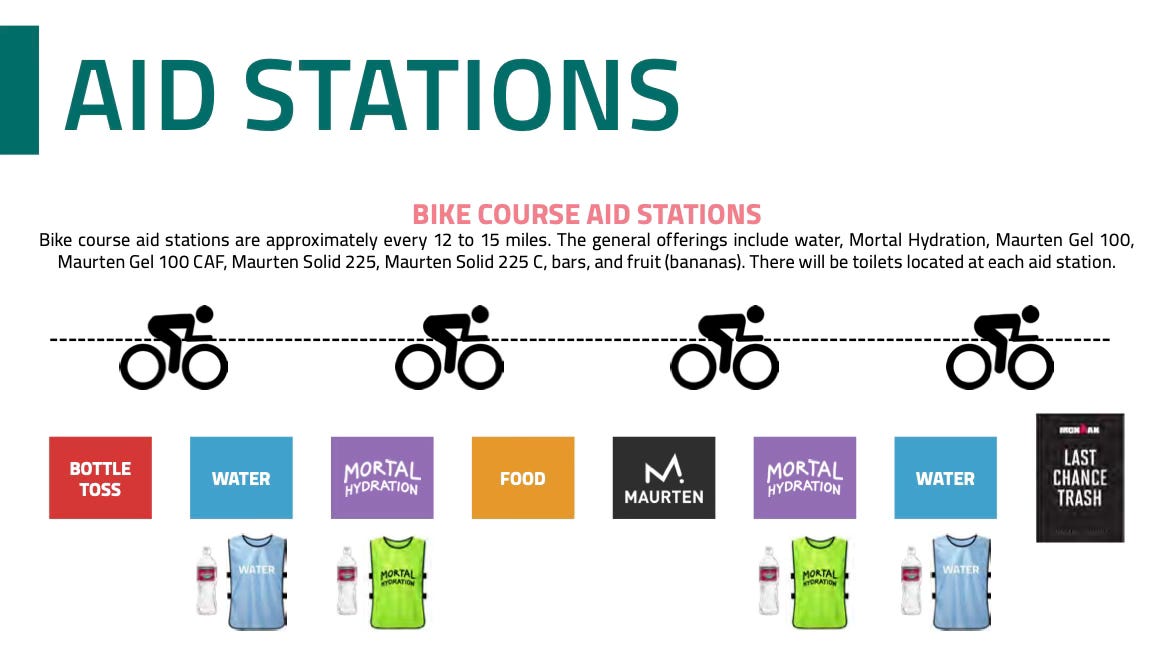
TIP: Ironman races have Maurten gels with caffeine (white) and without caffeine (black). Make sure you grab the one you want.
When you approach an aid station, the first thing to do is slow down. Flying through an aid station at 20 mph is a good way to drop bottles, and it’s dangerous for the other athletes and volunteers.
The first part of an aid station is the trash area or bottle drop. When I approach an aid station on the bike, the first thing I do is empty out whatever liquid I have left in my bottle into my aero bottle. That way, I can drop the empty bottle as I pass by.
Aid station volunteers will be holding out bottles so you can grab them as you ride by. Talk to the volunteers and tell them what you need. You can say “water” or “Maurten” and they often do the same.
TIP: Practice grabbing bottles during training. At the end of your next ride, have a friend stand on the right side of the road so you can practice grabbing a bottle with your right hand.
Be aware of what’s going on around you. As you approach an aid station, keep an eye on the riders ahead of you and glance back to see who is behind you. Keep enough space in between riders in case someone drops a bottle.
Be vocal. Talk to the other athletes and use hand signals so they know your intentions.
Don’t stop in the middle of the line. This is dangerous and interrupts the flow for everyone riding behind you. If you feel like you can’t grab a bottle safely while moving, it’s better to go all the way to the end of the line and stop at the port-potty, so you can walk back and get what you need.
Once you’ve grabbed whatever bottles and nutrition you need, you have one last chance to drop trash at the end of the aid station before getting back on course. If you have a bad aim, don’t worry. You won’t get a penalty if a bottle or cup falls on the side of the road, as long as you’re still in the designated trash zone. They just don’t want you dropping trash at random areas on course.
Here’s an acronym to help you remember what to do: FUEL
F– Focus on the flow- Be aware of your surroundings and stick to the aid station flow.
U- Use your voice- Tell other athletes where you’re going, and tell the volunteers what you need.
E– Ease up- Slow down when riding through aid stations.
L- Leave clean- Only drop trash at aid stations or face a penalty.
Obviously, aid stations on the run aren’t as tricky because you’re not riding a bike, but the same basic rules apply. Run aid stations have the same flow as bike aid stations except that many will have cups of ice or a large bucket of ice.
My run aid station procedure is this: First, ice goes in my sports bra. Next, a cup of water goes on my head. Finally, I grab whatever water I want to drink. Pinching the paper cup into a funnel helps me actually get most of it into my mouth while running.
TIP: Don’t be afraid to walk the aid stations if you need to reset your heart rate and get the nutrition you need. Flashback to Chelsea Sodaro winning at Kona in 2022. She had a blistering marathon of 2:51:45 and even she walked several aid stations. In a triathlon, it’s not always who goes the fastest, but who slows down the least.
I hope you’ve enjoyed How to Navigate Aid Stations Like a Pro. Remember to FUEL and you will do great at your next triathlon.
